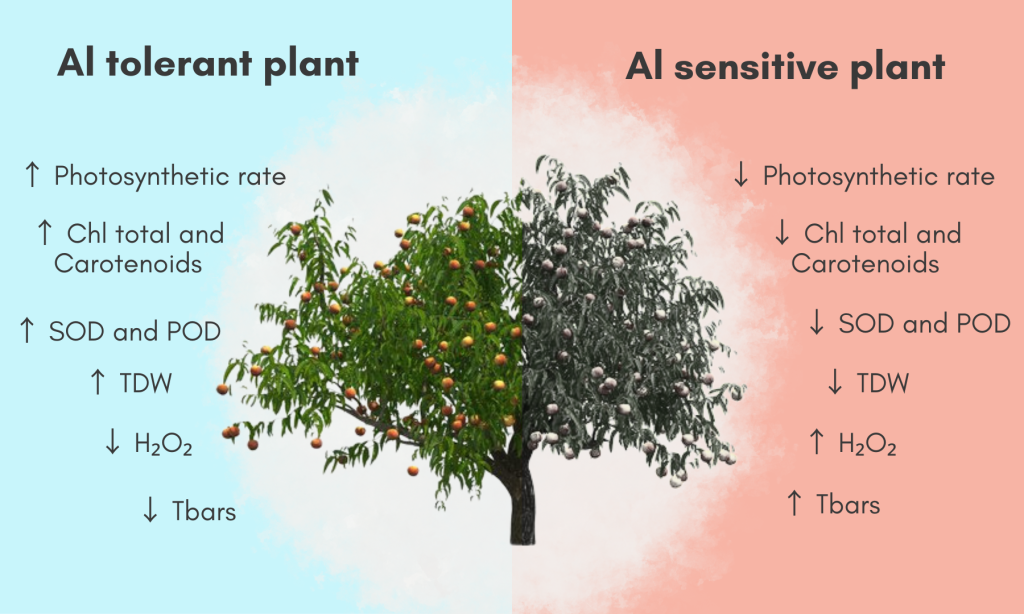Oxidative stress as markers in identification of aluminum-tolerant peach tree rootstock cultivars and clonal selections
11/Mar/2024
ABSTRACT Peach rootstock and scion cultivars are selected in breeding programs considering resistance to pests and diseases, salt tolerance, drought tolerance, and vigor. However, rootstock tolerance to aluminum (Al), which is markedly present in tropical and subtropical soils of the world, is not considered. Thus, it is essential to define potential markers that can contribute to the selection of Al-resistant or Al-tolerant peach rootstocks. The objective of this study was to identify Al-tolerant peach tree rootstock cultivars and clonal selections […]
Dry matter production, root growth and calcium, phosphorus and aluminum absorption by coffea canephora and coffea arabica under influence of aluminum activity in solution
01/Feb/2008
This study had the objective of evaluating the dry matter production, root growth, and the absorption and distribution of Ca, P and Al in the leaves, stem and roots of two Conilon (Coffea canephora) coffee clones (Mtl 25 and Mtl 27) and the coffee variety Catuaí Amarelo (Coffea arabica) grown in nutrient solution with increasing Al3+ activity. The plants were cultivated in 5 L pots, containing modified Hoagland & Arnold nutrient solution. After eight days of adaptation, the plants were subjected to Al […]
Interactions between magnesium, calcium, and aluminum on soybean root elongation
01/Oct/2005
Alleviation of Al rhizotoxicity by Ca and Mg can differ among species and genotypes. Root elongation of soybean [Glycine max (L.) Merr.] line N93-S-179 and cvs. Young and Ransom exposed to varying concentrations of Al, Ca and Mg were compared in two experiments using a vertically split root system. Roots extending from a surface compartment with limed soil grew for 12 days into a subsurface compartment with nutrient solution treatments maintained at pH 4.6 with either 0 or 15 µmol L-1 Al. Calcium and […]
Aluminum influence on growth and nutrient accumulation by young guava plants
01/Dec/2000
Young guava plants were grown in a nutrient solution in the presence of 0, 5, 10, 15, 20 and 25 mg L-1 aluminum, with pH being kept at 4.0. After 110 days, the plants were harvested and their content of macronutrients, Cu, Fe, Mn, Zn and Al were determined. Visual toxicity symptoms, developed under 20 and 25 mg L-1 aluminum, were as follows: reduction in height, absence of branching, decrease in diameter of stem dark roots and smaller leaves presenting […]
Aluminum tolerance in Panicum maximum
01/Jun/2000
Thirty Panicum maximum Jacq. genotypes were screened for aluminum tolerance at aluminum rates 0, 12 e 24 mg L-1 in nutrient solution. The effects of the aluminum in Al-induced inhibition of root elongation and Al-tolerance index allowed classification into three different Al tolerance groups: tolerant, medium and sensitive. Most of the genotypes presented moderate even low tolerance to aluminum toxicity, although K191, T95, T84, T91, Centenário were Al-tolerant and Centauro, K68, K214, T46 were Al-sensitive genotypes.
Aluminum influence on plants grown in a Brazilian Red-yellow Podzolic soil
01/Jun/1999
The present study was carried out in 1995 to investigate why plants cultivated in a Red-Yellow Podzolic in the State of Acre, in the Brazilian Amazon, presenting high amounts of exchangeable aluminum, have not shown symptoms of toxicity to this element or yield reduction. The exchangeable Al3+ in the B horizon is higher than 14 cmolc dm-3. Samples of the A and B horizons were incubated with increasing rates of lime and subjected to determination of pH in H2O, pH […]

